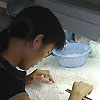- sale
- new items
- lovely beads
- wedding beads
- beads for teens
- for custom order
- newsletter
- recognition
- testimonials
- birthstones
- zodiac signs
- jewelry guide
SHOP BAG
![]() in your bag 0 items
in your bag 0 items
Each pearl type (freshwater pearls, saltwater pearls, Akoya pearls, Biwa pearls, South Sea pearls, Tahiti pearls) has its own characteristics due to the specific forming condition, and the pearl grading factors are normally not considered equal. Knowing pearl types is the precondition of evaluating pearls. Each type of pearls has its own characteristics and valued standards. Among different types of pearls, saltwater pearls are more valuable than freshwater pearls. Natural pearls cost more than cultured pearls.
Luster and Nacre
Pearl luster is the brilliancy and the soul of pearls. This chief evaluating factor separates the inferior pearls from superior and the ordinary from the extraordinary. As a natural attribute, the luster of a pearl depends on the quality of the nacre - its transparency, smoothness and overall thickness as well as the thickness of each of the microscopic layers of nacre. A very thin nacre thickness would reduce pearl luster, color evenness and durability and could never make a fine quality pearl. Freshwater pearls have a very thick pearl nacre. Akoya pearls nacre are the thinnest among all types of pearls.
Surface
Surface imperfections are part of pearls natural texture and proof of the pearl genuineness. Even though a pearl is considered more valuable when the surface imperfections are minimal, people should positively consider them more than negative when evaluating pearls. People always desire perfect pearls without any flaws, but in fact, the longer a pearl is in an oyster, the more possible it grows to be irregular and get blemish.
Color
Pearls come in a wide variety of colors, ranging from white all the way to black. The natural color of pearls results from a combination of body color, overtone and iridescence. The wearer's preference determines what color is the best for him/her. Fashion trends and color demand affects different color pearl price. But it is still important to find a color that is rich and evenly distributed on the pearl.
Shape
Perfectly round pearls are rarest and most valued. Symmetrical pearls are more valuable than baroque. However, baroque pearls, with their various shapes, can inspire talented jewelers or artists and be created into some amazing arts.
Size
The larger the size, the higher the price. But price jumps between pearl sizes are often uneven. Large pearls are more difficult to cultivate because of the large size of the implanted nucleus. There is an increased likelihood that the oyster will reject the nucleus.
Treatment
Most of pearls we see are treated more or less. Pearl treatment is a must process before these beautiful gemstones are put on market. There are many methods to treat pearl including polish, bleaching, dyeing, filling, irradiation, coating and oiling. Treated pearl doesn't mean low quality. People use a exquisite craft to make pearls perfect. That is much more like that a diamond can be call a diamond only after it is cut according to the rock's characteristics.


